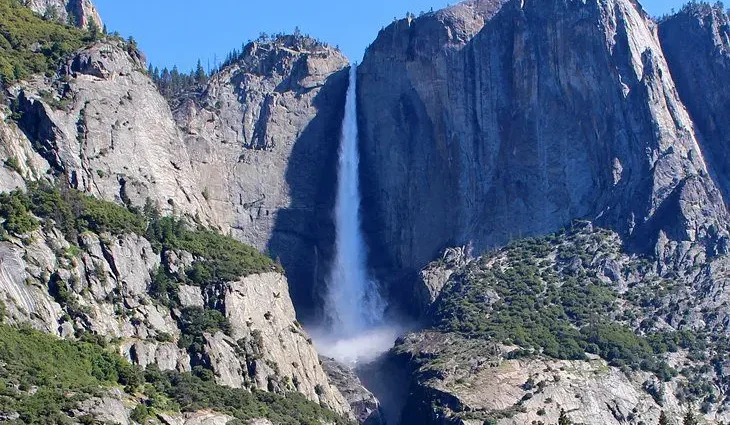Contents
- 1. Yosemite Falls Trail
- 2. Half Dome Hike
- 3. Mist Trail to Vernal Fall and Nevada Fall
- 4. Mirror Lake Trail
- 5. Sentinel Dome Trail
- 6. Cathedral Lakes
- 7. May Lake Trail and Mount Hoffmann
- 8. Bridalveil Fall Hike
- 9. Lower Yosemite Falls Trail
- 10. Taft Point
- 11. Soda Springs and Parsons Lodge
- Map of Hikes in Yosemite National Park
- Where to Stay near Yosemite National Park
- Getting to Yosemite
- More Hiking, Camping, and Outdoor Destinations in California
Famed for its waterfalls and granite walls, Yosemite National Park is home to some of the most iconic natural wonders in America. For hikers, this World Heritage Site is a playground of unparalleled proportion and perfect for all levels of ability.
Yosemite is home to one of the most challenging day hikes in the park’s system (Half Dome Trail) but also offers wheelchair accessibility to the base of Yosemite Falls, its most symbolic feature.
Yosemite Valley is open year-round for hiking, although some areas are inaccessible in winter. Trails here, particularly the shortest, are almost always busy. From late spring until fall, the hikes along Tioga Road and Glacier Point Road are open and take some of the pressure off the hiking trails in the valley.
A shuttle bus service operates in the valley. Visitors can park at Half Dome Village or Yosemite Village and access the shuttle to reach trailheads and sites.
For a closer look at the trails, see our list of the best hikes in Yosemite National Park.
1. Yosemite Falls Trail

The showpiece of Yosemite National Park, Yosemite Falls is like a visual magnet that practically calls out to hikers as you drive through the valley. This is the highest falls in North America, and it is truly one of the most striking sights in the park.
Hikers can get a close-up look at the falls, along with excellent views over Yosemite Valley from the Yosemite Falls Trail. You can hike 7.2 miles round-trip to the top of Yosemite Falls or opt for a two-mile round-trip hike to Columbia Rock.
The hike to the top of Yosemite Falls involves a heart-pounding, 2,700-foot elevation gain over a series of switchbacks, to a spectacular lookout, where you can also view the falls from above and the river that feeds it.
The falls are at their best in the spring, when the amount of water flowing over the ridge is at its peak. Total time for this hike ranges from about six to eight hours. This hike has long drop-offs, but most exposed sections have guard-rails or railings to grasp on the inside.
The less strenuous hike to Columbia Rock takes you up only 1,000 feet and can be done in two to three hours, round-trip. This is still a moderately demanding hike, with a series of switchbacks. From Columbia Rocks, you can get a great view down the valley, and another half-mile trail takes you to a great view of Upper Yosemite Falls.
If you are interested in hiking but don’t want to tackle longer hikes by yourself, you might want to consider looking into a guided hiking excursion at Yosemite . You can choose from beginner, intermediate, or advanced level hikes.
2. Half Dome Hike
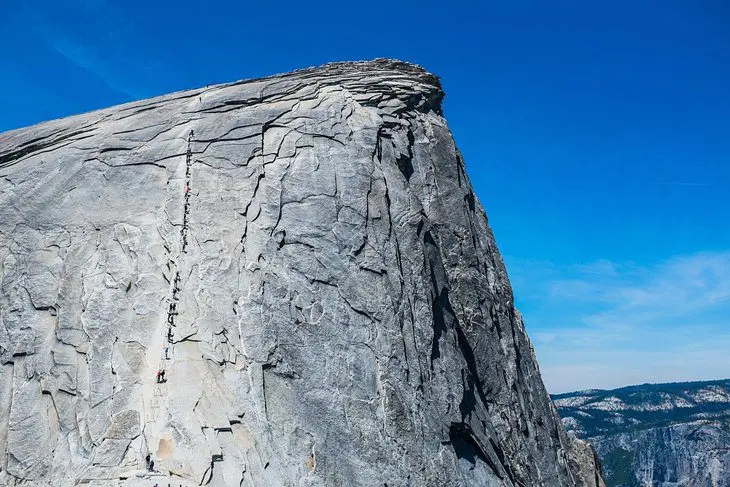
The hike up Half Dome, another of Yosemite’s iconic sites, is a bucket-list hike, best suited to adventurous hikers. If your idea of a great hike involves a 12-hour, 14-mile round-trip trek, massive elevation gain, cables, and something to write home about, this is the hike for you. This famous hike is a challenging trail, and it requires some advance planning, but if you have the time and energy, it’s worth tackling.
The Half Dome trail is an all-day hike for people who are in good physical shape. The trail starts out following the route of some of the other popular hikes in the park, beginning on the Mist Trail, up to Vernal Fall, and beyond to Nevada Fall. The final section of the hike up the backside of Half Dome is so steep and exposed, the park has installed cables to make the climb possible.
But even the hike up Sub Dome, to reach the cables, is serious work, with extremely steep and exposed terrain. The park has prepared a video on the Half Dome hike, so visitors know what they’re getting into before they attempt it. You can only reach the peak from about Memorial Day to Columbus Day. Outside of this season, the cables are removed.
Permits are required for this hike beyond the Sub Dome area. Only 300 hikers are allowed beyond this point each day (225 day hikers and 75 backpackers). Permits are issued via an online preseason lottery system each March.
In addition to the preseason lottery, each day approximately 50 day permits are issued, again via a lottery system. You will need to apply two days in advance from the day you would like to hike.
Two fees are charged: one for the application and a second for the actual permit, if you are successful. You can apply for seven different dates for a maximum of six hikers. Competition is fierce.
3. Mist Trail to Vernal Fall and Nevada Fall

The Mist Trail, which leads to the top of spectacular Vernal Fall, is one of the most popular hikes in the park. You can combine a series of hikes that include a short hike to the Vernal Fall Footbridge, followed by the Mist Trail, and beyond to Nevada Fall. This gives hikers a chance to turn back whenever they’ve had enough, while still reaching some spectacular views along the way.
The trail starts out alongside the Merced River and leads to the Vernal Fall Footbridge, where it crosses the river and provides good views, looking up at Vernal Fall. This is a .8-mile one-way hike to the Vernal Fall Footbridge, with 400 feet of elevation gain. Many hikers only hike to the footbridge, so this first portion is the busiest. Water and washrooms are available here.
On the opposite side of the footbridge, the path splits, with the John Muir Trail leading off to the right, and the Mist Trail branching to the left. The Mist Trail follows the river and Vernal Fall up a long series of stone stairs for another .7 miles, gaining an additional 600 feet in elevation.
As the name suggests, the mist from the waterfall along this section of stairs is constant, and you can expect to get wet. Many people wear rain jackets. Eventually, you reach the top of spectacular Vernal Fall, for a complete view of the falls and river below.
If you are up for a longer hike, you can continue up another long set of stairs to the top of Nevada Fall, an even more stunning sight. Total hike time to the top of Nevada Fall is five to six hours, covering just under 5.5 miles and 2,000 feet of elevation.
This is an in-and-out hike and returns following the same route. The trailhead is located at Happy Isles (stop 16) on the shuttle bus.
4. Mirror Lake Trail

Surrounded by Yosemite’s signature granite walls, Mirror Lake is a pleasant place to relax on a hot day, and the hike in is easy. It also offers one of the best close-up views of the face of Half Dome in the park.
Depending on your energy level, you can make the lake the destination, or do a complete loop up Tenaya Canyon and around the lake, following the river up one side and down the other. The return trip to Mirror Lake is 2.4 miles, and the complete loop around the lake is four miles.
Most people start the hike from shuttle stop #17, but the start of the trail can be confusing because trails lead up either side of the river. On the right side is a hiking path, on the left side is a paved access road, that leads to the lower pond below Mirror Lake.
If you only want to go to Mirror Lake, take the paved access road, and this will get you to the more popular side of the lake with views of Half Dome.
5. Sentinel Dome Trail
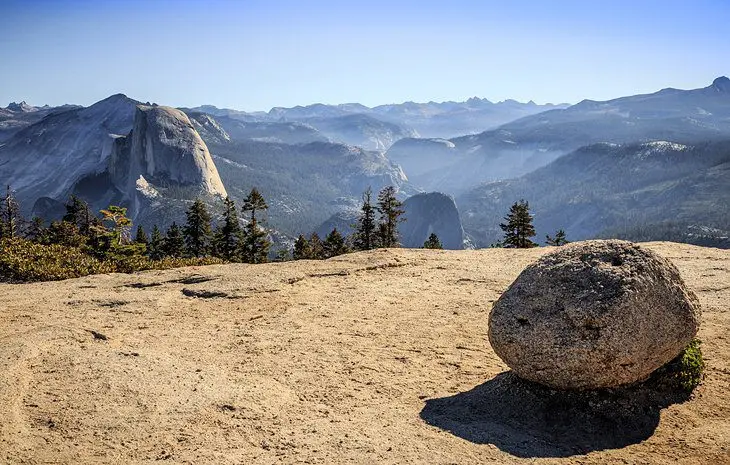
High above the Yosemite Valley, Sentinel Dome hike offers spectacular views without much physical effort. Looking out from almost 4,000 feet above the valley floor, you can see far into the distance, and see the famous sites of Half Dome and Yosemite Falls from a much different perspective than you get from driving through Yosemite Valley.
This hike is just over two miles long, and the total elevation gain is only about 400 feet, with most of the ascent occurring as you approach the highpoint of the Dome.
For photographers, this trail also has significance. Ansel Adams’ famous photo of the Jeffrey Pine was taken up here, and today you can still see the fallen tree.
This hike begins off the Glacier Point Road, which runs along a high ridge to the south of Yosemite Valley. Drive time from Yosemite Village is about one hour, but this area is usually much less crowded.
This is a seasonal hike, only open during the summer months, when the Glacier Point Road is open.
6. Cathedral Lakes
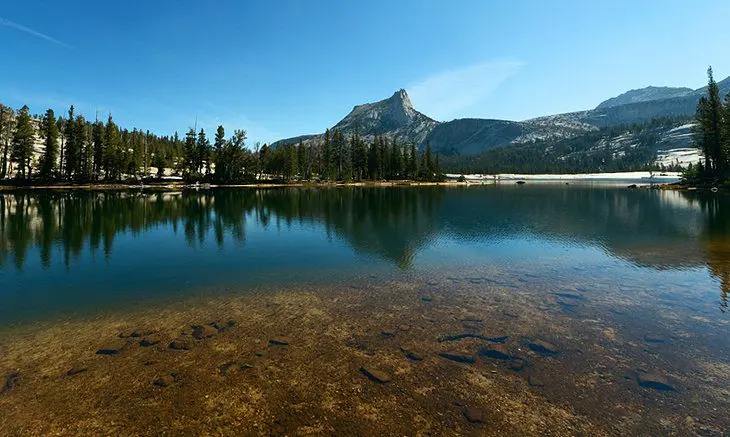
The Cathedral Lakes hike exposes you to the high alpine beauty found along the Tioga Road. You can hike to both Upper and Lower Cathedral Lake, for an eight-mile round-trip hike, or just hike to either one for a seven-mile return hike.
Most hikers just hike to Lower Cathedral Lake, the more scenic of the two. This is the larger of the two lakes, and it offers a peaceful place to relax and enjoy a picnic. The grey granite shores and surrounding mountains contrast with the dark blue of the lake. The calm water reflects Cathedral Peak.
Don’t be surprised if you find yourself out of breath on this hike. Both lakes are set well above 9,000 feet, and the elevation gain on this hike is about 800 feet to Lower Cathedral Lake and 1,100 feet to Upper Cathedral Lake.
The trail begins from Tuolumne Meadows and is part of the John Muir Trail. Since this road is only open in summer, this is a seasonal hike.
7. May Lake Trail and Mount Hoffmann
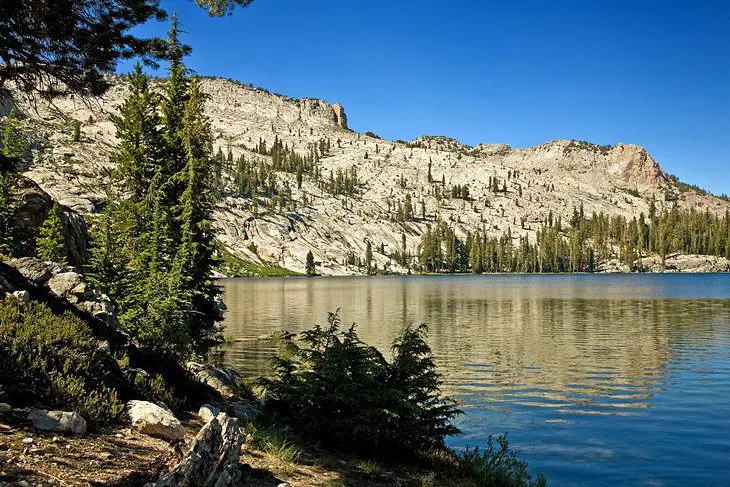
If you’re looking for a short but scenic hike along the Tioga Road, May Lake Trail is the perfect option. This 2.5-mile round-trip hike gains about 500 feet in elevation, and it’s a steady climb up to the lake. Scenic lookouts, with views over the mountains, forest, canyons, and beyond to Half Dome, break up the trek.
At Lake May, you can relax, or if you decide you’re up for a much longer hike, you can tackle Mount Hoffmann, rising above Lake May. This will add on 3.5 miles round-trip to your hike, plus almost another 1,600 feet in elevation. The 360-degree view from Mount Hoffman is spectacular, taking in the entire area, with the added bonus of a view over May Lake.
As with Cathedral Lakes, this hike is only possible when the Tioga Road is open.
8. Bridalveil Fall Hike
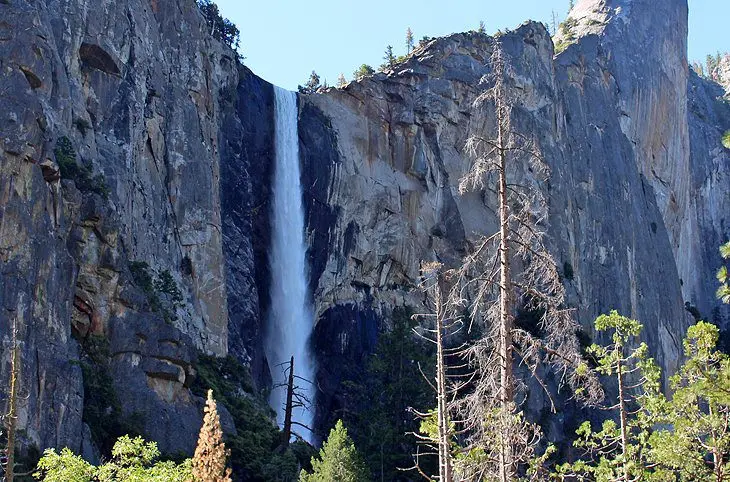
This hike is really just a short walk, but considering this waterfall is one of the big attractions in Yosemite Valley, it’s worth taking the time to stop and walk the 1.2-mile round-trip trail.
You can get right to the base of the waterfall and feel the mist on your face as the water hits the rocks, after tumbling 620 feet from the top of the cliff wall. The trail is quite level and requires little effort.
If you are heading into the Valley on Wawona Road, Bridalveil Fall is the first parking area past Tunnel View.
9. Lower Yosemite Falls Trail

Yosemite is one of the most beautiful parks in the United States, and Yosemite Falls is one of the most incredible sites the park has to offer.
Fortunately, the paved trail to the base makes it very accessible. This half-mile trail can accommodate wheelchairs on the eastern side of the loop.
This is where you’ll also find one of the nicest views of the upper and lower falls through the trees. You can take a shuttle to the trailhead, or you can walk from Yosemite Village, for a 1.5-mile round-trip stroll.
10. Taft Point
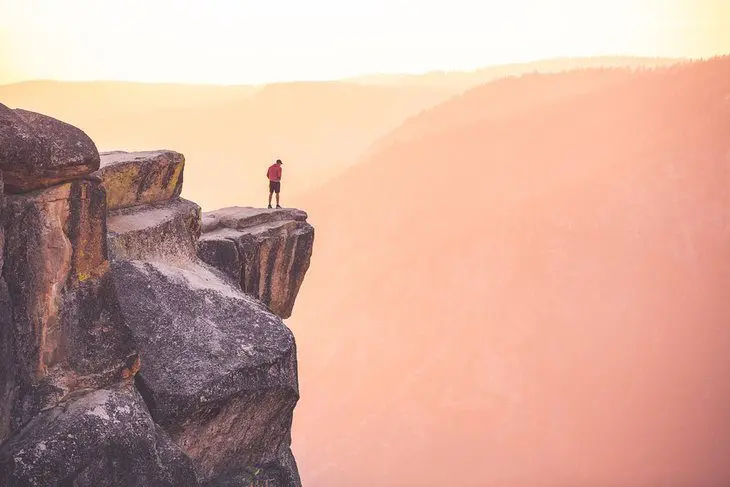
Taft Point offers commanding views up and down the valley and to El Capitan. There are no guardrails here, and the drop from the cliff edge is, without a sliver of a doubt, fatal. This hike is not recommended for families with small children.
The hike is 2.2 miles return and is fairly easy, with very little elevation gain. Along the trail, you’ll pass by an area called The Fissures. These fascinating geologic features consist of deep gashes in the rock leading right out to the valley below.
11. Soda Springs and Parsons Lodge
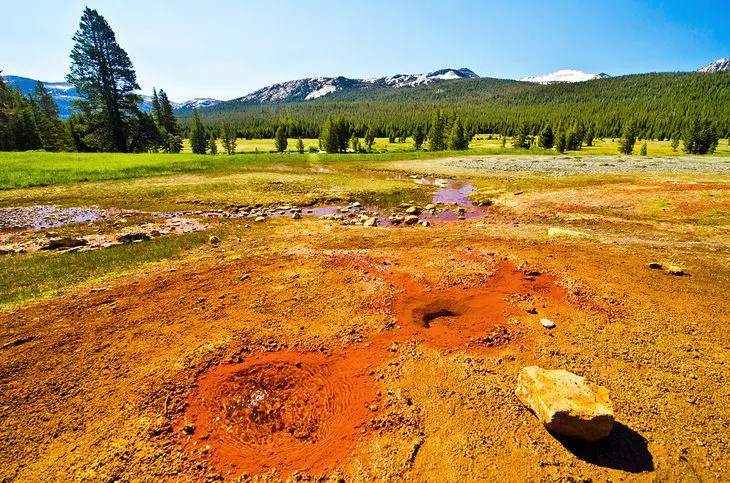
If you are looking for an easy hike with a bit of history combined with a unique geological feature, check out the Soda Springs and Parsons Lodge trail. This 1.5-mile round-trip hike is on level ground along a jeep trail and is suitable for families with small children.
The main attraction is the soda springs, where carbonated waters emerge from deep within the earth. Nearby is Parsons Lodge, dedicated to an early environmental activist. Inside are various displays and exhibits of interest.
Try to visit early in the season, when the surrounding meadows burst forth with a colorful display of spring wildflowers.
Map of Hikes in Yosemite National Park
Where to Stay near Yosemite National Park
For the ultimate in convenience and luxury, the best place to stay is at a lodge in Yosemite National Park. If you have camping equipment, you’ll find plenty of good camping options in and around the park. Hotels and other accommodation outside the park are surprisingly limited and will require some commute time. Below are some of the best hotel options in the vicinity:
In the Park:
- The Awhahnee is a beautiful 1927 lodge, classified by the National Parks system as a Premier Lodge. Listed on the National Register of Historic Places, and also a National Historic Landmark, this luxury hotel is located in the most prime location possible in Yosemite Valley. The design features a stone façade, open-beamed ceilings, and grand common rooms. Guest rooms are more modern but tastefully decorated.
- Another historic hotel in the park is the Wawona Hotel . Built in 1876 this wonderful old wooden hotel is a delightful place to stay with many of the rooms have large verandas out front with views of the gardens and 9-hole golf course across the street.
El Portal:
- The two-story Yosemite Cedar Lodge , in the nearby town of El Portal is a good option, particularly for families. Spacious rooms are quiet, and some offer full kitchens and separate bedrooms. Commute time to Yosemite Village, along Highway 140, is just 30 minutes.
Highway 120 and Groveland:
- About 50 minutes from Yosemite Valley, along Highway 120, Rush Creek Lodge offers rooms and suites with balconies, an on-site outdoor pool, a games room, and restaurant.
- Slightly farther out, closer to the town of Groveland, is the comfortable Yosemite Westgate Lodge .
- In the town of Groveland are the Hotel Charlotte and The Groveland Hotel , both quaint little properties with small-town charm.
Getting to Yosemite
From San Francisco:
- The main gateway city to Yosemite is San Francisco. Getting from San Francisco to Yosemite National Park is fairly easy, and there are several options. You can drive yourself, take a tour, or hop on public transportation.
- The drive time between these two destinations is about four hours, depending on traffic. The fastest route is on Highway 120, but you can also take Highway 140.
From Los Angeles:
- If you are starting from LA, it’s a longer trip to the park but there are still multiple ways of getting there. By car, it’s about a 10-hour drive. By public transportation, it’s a bit more difficult, but our article Getting from Los Angeles to Yosemite explains the various methods and modes of transport, including driving yourself.
More Hiking, Camping, and Outdoor Destinations in California

Hiking: California’s diverse landscapes offer a wealth of opportunities for unique hiking experiences. Wander among the towering redwoods on the best hikes in Redwood National and State Parks, or along the shores of Lake Tahoe, with help from our feature article on the Top Hikes around South Lake Tahoe. If you’re not sure where to begin, have a look at our Best Hikes in California.
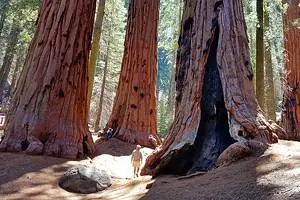
Camping: One of the best ways to experience California’s natural areas is to camp on location. If you are hiking in Yosemite, the campgrounds in and around Yosemite are incredibly convenient and can shave hours off your commute time, to and from the park.
Another big attraction in California is the giant trees, and these are exceptional areas for camping. For more ideas, see our articles on the best campgrounds in Redwood National and State Parks, Sequoia National Park, and Kings Canyon National Park. All of these also have great hiking trails. For a taste of the desert, try camping in Joshua Tree National Park.










